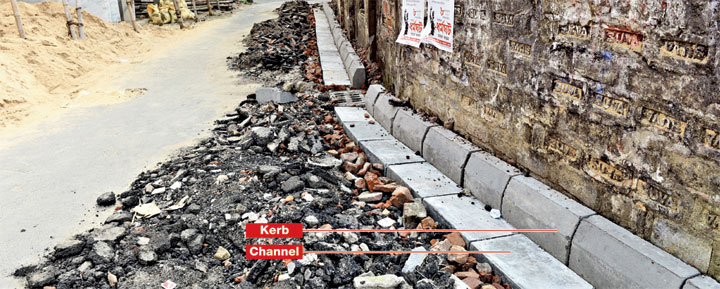Roads, lanes and bylanes in added areas of Calcutta are being upgraded with kerbs and channels on either side to ensure water flows out quickly, a move that will increase the lifespan of the carriageways.
Wards 101 to 144 are commonly referred to as added areas because they were added to the Calcutta Municipal Corporation (CMC) in 1984, much later than the first 100 wards.
Vertical slabs rising from the road surface are called kerbs, while a series of slabs placed horizontally beside kerbs form a channel, an engineer of the CMC said.
A channel works like a conduit. It remains inclined towards the nearest gully pit and carries rainwater into the pit.
“The system enables water to flow into underground sewers fast and prevents degeneration of the road surfaces by avoiding waterlogging. A road that often gets flooded disintegrates fast because water unbinds the bitumen,” the engineer said.
The CMC aims to gird all roads and lanes and most bylanes with kerbs and channels, an official said. “All arterial roads such as Central Avenue and Rashbehari Avenue, and even lanes and bylanes in wards 1 to 100 have kerbs and channels. Work is under way to cover wards 101 to 144,” the official said.
Extensive work to lay kerbs and channels is under way in wards 107, 108 and 109 — in the Kasba-Jadavpur belt — and wards 111, 113 and 114 — in the Garia-Tollygunge belt, another official said.
In added areas, only about 30 per cent of the road length is without kerbs and channels.
“A road usually slopes towards its sides, where horizontal slabs are placed to create a channel. When it rains, the water flows towards the channel and from there to the gully pit because of the incline,” said the engineer.
“If water is drained out from a road quickly, the surface will last longer. Water is the biggest enemy of bitumen and a waterlogged road wears out within months.”
Usually, a road has to be at least 12ft wide to have kerbs and channels on either side. Narrower roads are mostly made of concrete, which is unaffected by water.
The kerbs also serve the purpose of demarcating a road from a private land.
“In several places, buildings have encroached on road space. The kerbs would help us demarcate the road space and prevent encroachment,” an official said.
“The kerbs also help raise the height of footpaths. Besides, freshly painted kerbs make a road look better. We paint kerbs in regular intervals. The fresh paint also apprise motorists about the edge of a road.”











